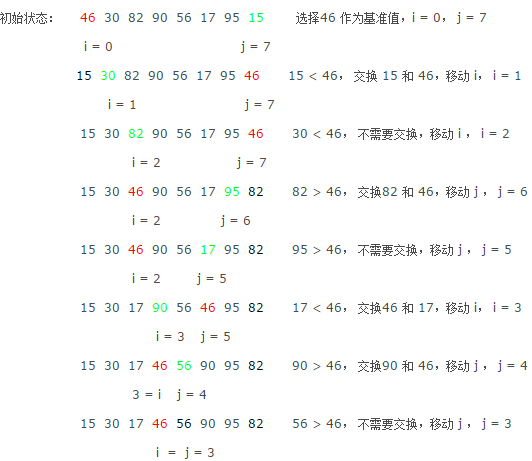这里总结了一下我们平时常用的集中排序方法,供大家学习参考
1、插入排序 每次从无序表中取出第一个元素,把它插入到有序表的合适位置,使有序表仍然有序。
直接插入排序算法时间复杂度:O(n^2);空间复杂度:O(1)。直接插入排序是稳定的排序方法。
1 2 3 4 5 6 7 8 9 10 11 12 13 14 15 16 17 18 19 20 21 22 23 24 25 #include<iostream>
2、冒泡排序 冒泡排序时间复杂度,最好情况:数组已有序O(n);最坏情况:数组反序O(n^2),平均时间复杂度:O(n^2)。空间复杂度,冒泡排序是原地排序,空间复杂度为O(1)。冒泡排序算法是稳定的排序算法。
1 2 3 4 5 6 7 8 9 10 11 12 13 14 15 void bubble_sort(int a[], int n)
3、直接选择排序 无序数组a[0…n-1],第一次从a[0]a[n-1]中选取最小值,与a[0]交换,第二次从a[1]a[n-1]中选取最小值,与a[1]交换,….,第i次从a[i-1]a[n-1]中选取最小值,与a[i-1]交换,…..,第n-1次从a[n-2]a[n-1]中选取最小值,与a[n-2]交换,总共通过n-1次,得到一个按关键字从小到大排列的有序序列·
在直接选择排序中,共需要进行n-1次选择和交换,每次选择需要进行 n-i 次比较 (1<=i<=n-1),而每次交换最多需要3次移动,因此,总的比较次数C=(n*n - n)/2,时间复杂度O(n^2)。直接选择排序为原地排序,空间复杂度O(1)。直接选择排序不是稳定的排序算法。
1 2 3 4 5 6 7 8 9 10 11 12 13 14 15 16 17 18 19 20 //直接选择排序
4、归并排序 时间复杂度为O(nlogn) 是归并排序算法中最好、最坏和平均的时间性能。空间复杂度O(n)。归并排序比较占用内存,但却是一种效率高且稳定的排序算法算法。
1 2 3 4 5 6 7 8 9 10 11 12 13 14 15 16 17 18 19 20 21 22 23 24 25 26 27 28 29 30 31 void Merge(int sourceArr[],int tempArr[], int startIndex, int midIndex, int endIndex)
5、快速排序 快速排序算法平均时间复杂度O(nlgn),最坏O(n^2)。快速排序需要栈空间来实现递归,如果数组按局等方式被分割时,则最大的递归深度为 log n,需要的栈空间为 O(log n)。最坏的情况下在递归的每一级上,数组分割成长度为0的左子数组和长度为 n - 1 的右数组。这种情况下,递归的深度就成为 n,需要的栈空间为 O(n)。快速排序不是稳定排序算法。
算法说明:
1 2 3 4 5 6 7 8 9 10 11 12 13 14 15 16 17 18 19 20 21 22 23 24 25 26 27 28 29 30 31 32 33 34 35 36 37 38 39 void sort(int *a, int left, int right)

